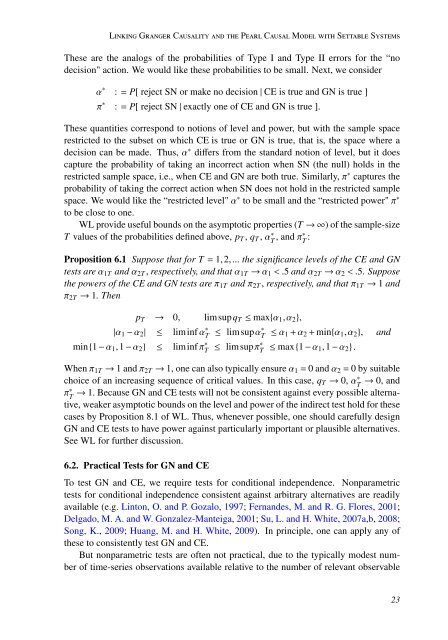Causality in Time Series - ClopiNet
Causality in Time Series - ClopiNet
Causality in Time Series - ClopiNet
Create successful ePaper yourself
Turn your PDF publications into a flip-book with our unique Google optimized e-Paper software.
L<strong>in</strong>k<strong>in</strong>g Granger <strong>Causality</strong> and the Pearl Causal Model with Settable SystemsThese are the analogs of the probabilities of Type I and Type II errors for the “nodecision" action. We would like these probabilities to be small. Next, we considerα * : = P[ reject SN or make no decision | CE is true and GN is true ]π * : = P[ reject SN | exactly one of CE and GN is true ].These quantities correspond to notions of level and power, but with the sample spacerestricted to the subset on which CE is true or GN is true, that is, the space where adecision can be made. Thus, α * differs from the standard notion of level, but it doescapture the probability of tak<strong>in</strong>g an <strong>in</strong>correct action when SN (the null) holds <strong>in</strong> therestricted sample space, i.e., when CE and GN are both true. Similarly, π * captures theprobability of tak<strong>in</strong>g the correct action when SN does not hold <strong>in</strong> the restricted samplespace. We would like the “restricted level" α * to be small and the “restricted power" π *to be close to one.WL provide useful bounds on the asymptotic properties (T → ∞) of the sample-sizeT values of the probabilities def<strong>in</strong>ed above, p T , q T , α * T , and π* T :Proposition 6.1 Suppose that for T = 1,2,... the significance levels of the CE and GNtests are α 1T and α 2T , respectively, and that α 1T → α 1 < .5 and α 2T → α 2 < .5. Supposethe powers of the CE and GN tests are π 1T and π 2T , respectively, and that π 1T → 1 andπ 2T → 1. Thenp T → 0, limsupq T ≤ max{α 1 ,α 2 },|α 1 − α 2 | ≤ lim<strong>in</strong>f α * T ≤ limsupα* T ≤ α 1 + α 2 + m<strong>in</strong>{α 1 ,α 2 }, andm<strong>in</strong>{1 − α 1 ,1 − α 2 } ≤ lim<strong>in</strong>f π * T ≤ limsupπ* T ≤ max{1 − α 1,1 − α 2 }.When π 1T → 1 and π 2T → 1, one can also typically ensure α 1 = 0 and α 2 = 0 by suitablechoice of an <strong>in</strong>creas<strong>in</strong>g sequence of critical values. In this case, q T → 0, α * T→ 0, andπ * T→ 1. Because GN and CE tests will not be consistent aga<strong>in</strong>st every possible alternative,weaker asymptotic bounds on the level and power of the <strong>in</strong>direct test hold for thesecases by Proposition 8.1 of WL. Thus, whenever possible, one should carefully designGN and CE tests to have power aga<strong>in</strong>st particularly important or plausible alternatives.See WL for further discussion.6.2. Practical Tests for GN and CETo test GN and CE, we require tests for conditional <strong>in</strong>dependence. Nonparametrictests for conditional <strong>in</strong>dependence consistent aga<strong>in</strong>st arbitrary alternatives are readilyavailable (e.g. L<strong>in</strong>ton, O. and P. Gozalo, 1997; Fernandes, M. and R. G. Flores, 2001;Delgado, M. A. and W. Gonzalez-Manteiga, 2001; Su, L. and H. White, 2007a,b, 2008;Song, K., 2009; Huang, M. and H. White, 2009). In pr<strong>in</strong>ciple, one can apply any ofthese to consistently test GN and CE.But nonparametric tests are often not practical, due to the typically modest numberof time-series observations available relative to the number of relevant observable23





